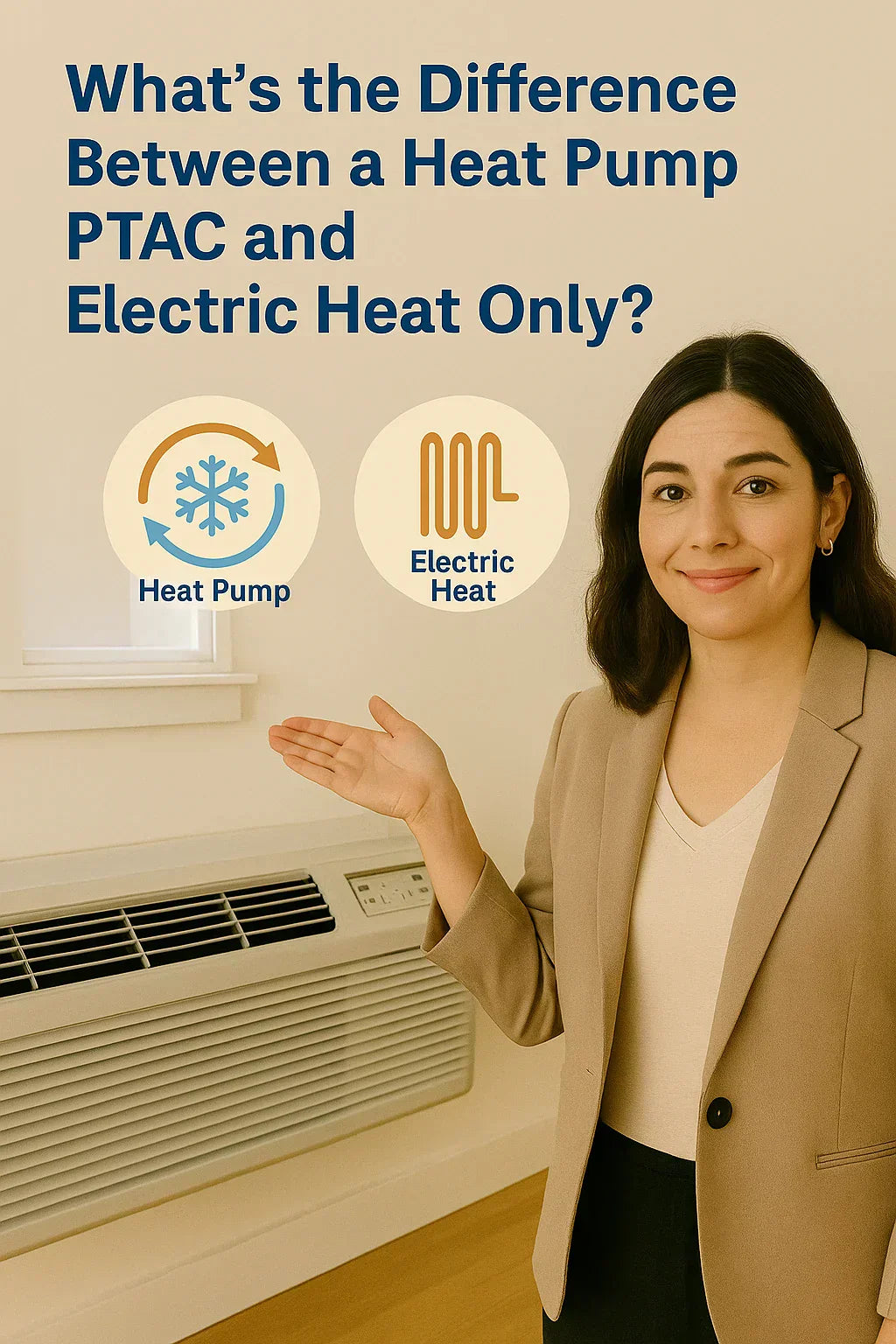When shopping for a PTAC (Packaged Terminal Air Conditioner) unit, one of the most important decisions is choosing between a heat pump model and an electric heat only model. While both can heat a room, they do it very differently—and that impacts your comfort, efficiency, and utility bills.
In this guide, we’ll break down the key differences between heat pump and electric resistance heat in PTACs so you can choose the right solution for your home, rental, studio, or ADU. Whether you’re outfitting a guest room or upgrading an older system, understanding how these technologies work is essential.
🔌 What Is Electric Resistance Heat in a PTAC?
Electric heat-only PTAC units work by passing electricity through resistance coils (similar to a toaster or baseboard heater). A blower fan pushes room air over these coils and back into the room.
Pros:
-
Simple and reliable
-
Heats well in any temperature
-
Inexpensive upfront cost
Cons:
-
Uses a lot of electricity
-
Higher monthly operating costs
-
Less efficient than heat pumps
Electric-only PTACs are commonly used in hotel rooms, northern U.S. homes, or as backup heat in colder climates.
❄️ What Is a Heat Pump PTAC?
A heat pump PTAC uses a reversible refrigerant cycle to both cool and heat a space. It works like an air conditioner in reverse during winter months, extracting heat from the outside air and moving it indoors.
Pros:
-
Much more efficient (COP up to 3.5)
-
Lower utility bills
-
Eco-friendly heating method
Cons:
-
May struggle in sub-freezing temperatures
-
Slightly higher initial cost
-
More complex (refrigerant system + reversing valve)
Many modern PTAC units, like the Hotpoint AHHS07D3XXA, combine both: they use a heat pump as the primary source and a 3.5 kW electric heat kit as backup for extreme cold.
📈 Heat Pump vs. Electric Heat Only: Side-by-Side Comparison
| Feature | Heat Pump PTAC | Electric Heat Only PTAC |
|---|---|---|
| Heating Efficiency | High (COP 2.5–3.5) | Low (COP = 1.0) |
| Operating Cost | Lower | Higher |
| Climate Suitability | Best in mild to moderate climates | Suitable for all climates |
| Backup Heat Required? | Yes (often included) | No |
| Maintenance Needs | Moderate | Low |
| Upfront Cost | Higher | Lower |
| Environmental Impact | Lower (uses ambient heat) | Higher (uses full electricity) |
🌬️ Real-World Heating Performance
Heat Pump Units:
-
Maintain heating efficiency in temperatures above 35°F
-
Drop in efficiency at or below freezing
-
May switch to electric backup automatically if too cold
Electric Heat Units:
-
Provide full heating capacity regardless of outside temperature
-
No efficiency drop, but higher electricity usage
🌍 Climate Zone Matters: Where Do You Live?
Your climate should guide your heating choice. Here’s how:
Ideal for Heat Pump PTAC:
-
Southeastern and Southwestern U.S.
-
Coastal areas with mild winters
-
Average low temps above 25°F
Ideal for Electric Heat Only PTAC:
-
Northern states and mountain zones
-
Homes with frequent sub-freezing temps
-
Areas where power cost is not a major concern
Use the DOE Climate Zone Map to find your region.
💸 Cost Comparison: Which Saves More Over Time?
| Cost Category | Heat Pump PTAC | Electric Heat Only PTAC |
| Unit Cost | $800–$1,200 | $600–$1,000 |
| Annual Energy Cost* | $150–$250 | $300–$500+ |
| Payback Period | 2–4 years | — |
*Based on average 500-hour heating season in a 300 sq ft room
In areas where electricity is expensive, a heat pump PTAC can save hundreds per year, quickly offsetting its higher price.
🔧 Installation and Power Differences
Electrical Load:
-
Heat pump + backup heat: often requires 230V / 20A or 30A
-
Electric-only units may require lower amperage, but still need 208/230V
Plug Types to Know:
-
NEMA 6-15P: Lower heat load (15A)
-
NEMA 6-20P or 6-30P: Higher capacity heat kits
NOTE: Always check breaker capacity and wire gauge. If unsure, consult a licensed electrician.
🛌 Real-Life Scenarios: Which Works Best?
🏠 Savvy’s Home Office (Dallas, TX)
-
280 sq ft converted bedroom
-
Moderate winters (rarely below 30°F)
-
Installed Hotpoint 7,000 BTU PTAC with heat pump and 3.5kW backup
-
Runs heat pump most of the year, electric backup used only 5-10 days
🛏️ Rental Cabin in Maine
-
Harsh winters, lows often below 0°F
-
Owner chose electric heat-only PTAC for guaranteed heat anytime
-
Higher bills, but consistent performance
🏡 Airbnb in Southern California
-
300 sq ft detached unit
-
Installed a heat pump-only PTAC, no backup
-
Operates efficiently all year with very low electricity usage
✅ Final Verdict: Which Should You Choose?
| Choose This If... | Go With... |
| You live in a mild/warm climate | Heat Pump PTAC |
| You experience sub-freezing temperatures | Electric Heat PTAC |
| You want lower heating costs | Heat Pump PTAC |
| You need maximum reliability | Electric Heat PTAC |
| You want a hybrid for best of both worlds | Heat Pump + Backup Kit |
Savvy recommends the hybrid option for most homeowners: a heat pump PTAC with backup electric heat gives you year-round comfort and lower bills in moderate climates.
📄 Helpful Links
In the next topic we will know more about: Can a PTAC Heat Pump Handle Winter? How the Hotpoint Unit Performs in Cold Weather







